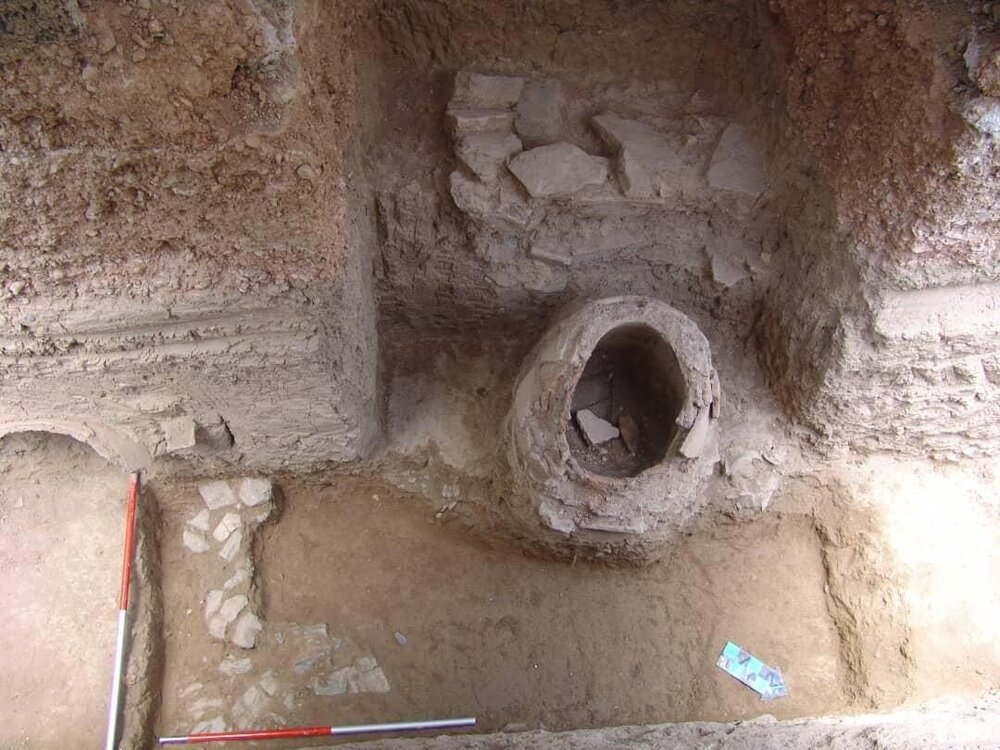Newly unearthed workshops may push back history of Isfahan by millennia

TEHRAN – Archaeologists have unearthed the ruins of two workshops, estimated to date from the Parthian era (247 BC – 224 CE), in Isfahan in a significant discovery that may push back the history of the central Iranian city in time by millennia.
“The structures of two Parthian workshops – one, relating to a metal melting kiln and the other to a fruit juice extraction, were discovered in a follow-up survey which is underway at Tepe Ashraf, the sole archaeological hill in Isfahan,” IRNA quoted senior archaeologist Alireza Jafari-Zand as saying on Monday.
“The metal melting workshop was reached in the fiftieth trench dug at the archaeological hill. This workshop was made of three interconnected rows of nested pottery and on the base of a carcass stone. And, around the walls of this Parthian structure, severe burns and welding signs exists. Moreover, a Parthian coin was found in one of the walls of this kiln,” Jafari-Zand, who heads the archaeological excavation, explained.
“Most silver coins were minted on the borders or outside the empires, but the copper coins were mostly local. The coin found in the metal melting workshop of the Ashraf hill is a Parthian copper coin with Greek letterings on it.”
“The metal smelting workshop is only a part of a large workshop, and 10 meters away from which another Parthian-era workshop producing grape extract was discovered, and these structures brightly show that in Ashraf hill of Isfahan, was part of an urban region belonging to the times of Parthians.”
The archaeologist emphasized, “We are not only dealing with a military fortress or an aristocratic house on Ashraf hill, but we are facing an [ancient] urban area in this place, and the workshops obtained in recent days show this well.”
Last month, Jafari-Zand and his team discovered an ancient giant jar-tombs (the second of its kind in the same place) inside the hill that the cement an idea that the history of Isfahan may be rooted deeper in the history. Isfahan is mostly recognized as a jewel of Islamic architecture of the 16th and 17th centuries.
“The discovery of the second giant jar-tomb in the sole historical hill of Isfahan – (‘Tepe Ashraf’ or ‘Tappeh Ashraf’) -- has proved a previous hypothesis suggesting the existence of a Parthian-era cemetery on the east of the hill. Now, Tepe Ashraf is the second place after the Tepe Sialk (in Isfahan province) that has yielded the discovery of such jar tombs that offers valuable clues to uncover the obscure history of pre-Islamic Isfahan,” Jafari-Zand explained.
Later, the team found a burial place containing the remains of a horse -- estimated to be four years old – in the hill. The horse skeleton was found near a place where a giant jar-tomb was unearthed.
“The burial of this horse with its head turned towards the animal’s body, shows an official burial which was practiced during the early years of the Parthian era. In this type of burial, the animal's body was buried next to its owner, who had died,” IRNA quoted Jafari-Zand as saying.
“Evidence came to light from some Parthian cemeteries, being excavated in northern Iran, shows that the deceased’s horse was buried next to him, and this fully shows that we have the same burial [tradition] in Isfahan, the discovery of this type of burial in Ashraf hill is of high importance for the history of Isfahan because no such phenomenon has been reported in central Iran so far.”
Excavations at Tepe Ashraf initially began in 2010 when Jafari-Zand announced his team found evidence at the site suggesting that the Sassanid site had also been used during the Buyid dynasty (945–1055). “We stumbled upon a reconstructed part in the ruins of the castle, which suggests that the structure had been used during the Buyid dynasty.”
“Isfahan is a city, which has never died over the history… and the old Isfahan is beneath the modern city. Thus, normally, archaeological excavation is impossible in the city,” according to Jafari-Zand who believes that the mount keeps a part of the history of Isfahan and Iran in its heart. The mound has seriously been damaged on the northern side by the construction of a street. Besides, unscientific excavations carried out by several archaeology interns in 1987 disturbed the historical strata in a part of the site.
Soaked in a rich history, Isfahan was once a crossroads of international trade and diplomacy in Iran during the 16th and 17th centuries, and now it is one of Iran’s top tourist destinations for good reasons.
Isfahan is filled with architectural wonders such as unmatched Islamic buildings, bazaars, museums, Persian gardens, and tree-lined boulevards. It's a city for walking, getting lost in its mazing bazaars, dozing in beautiful gardens, and meeting people. It has long been nicknamed as Nesf-e-Jahan which is translated into “half of the world”, suggesting that seeing it is equivalent to seeing half of the world.
AFM/MG
Leave a Comment